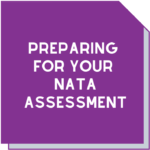Lab report writing 101
 You are an expert in your lab.
You are an expert in your lab.
You know your procedures and can carry these out with your eyes closed (although from a safety perspective we hope this isn’t happening!).
Once you’ve carried out your activity, you can put that information into your data collection device and that spits out your lab report. Or perhaps you go old school and type the report up.
But are you sure that the lab report you’re producing is the best it can be?
A lab report doesn’t just state what you’ve done. A well-written, clear, and concise report can enhance the reputation of your lab to both customers and an accreditation body. It’s helpful to put yourself in the shoes of your customers in setting up the format for a report. Just because there is a list in a Standard doesn’t mean you have to present information in that order.
Here’s a rundown on what to include in a good lab report.
Lab report headings
Lab reports usually have several sections which should be easily identified. There’s no need to be creative here – clarity is the most important factor. Calling the document a Laboratory Report is a great start, and it ticks off that pesky requirement to have a title.
What’s in a name
Think of this as a special letter writing exercise (remember those days?) where you had the details of the recipient, date, and your address at the top and your signature at the bottom. Reports are no different to a pre-formatted letter.
Your report will probably be on letterhead, so your company name, address and logo are automatically generated.
The name and contact details of the client you’re carrying out the test for along with the date and unique identifier should be at the top of the report.
Specify the test site or location of testing on the report. Sorry, we don’t have a great reason for this, other than it’s in the Standard. Find some place in the report where this detail doesn’t detract from the main focus.
Page numbers are always helpful in case pages get lost or mixed up. Imagine reading a letter from your Mum about the funny exploits of your Dad. Half way through the story you start reading about the dog because the pages got scrambled. As well as losing the impact, it can be very confusing so pagination will ensure everyone gets the full story as it is meant to be told. Telling the client when they’ve reached the end of the report is also useful.
Finally, the name of the person authorising the report also needs to appear, typically at the end of the report.
 Samples
Samples
Just like any friendly letter, you need to give the recipient an idea of what you’ve been up to. Information on the who, what and when of the laboratory’s activities needs to be given to the client.
Reports must include information on the methods used for testing, details of what sample was tested in terms that the customer and you can understand, and the dates of testing.
Depending on the type of test you’re carrying out, details of the samples should also be listed. For example, when the sample was collected, how the sample was received (e.g. plastic container, glass bottle); temperature on receipt; the appearance of the sample (e.g. cloudy liquid, viscous substance) and how it was treated on receipt (e.g. refrigerated). This will reassure your customers that their samples have been treated with care.
A section for sampling procedure could be helpful if you have anything to do with this activity or if it is important information to put the results into context. If a client requests a particular procedure which is outside your regular scope or process, that information could be listed here.
Results
This is probably one of the most important pieces of information you’re communicating to your customers, so it really needs to be clear. Test results are easier to read in table format. List the test, the method, the units of measurement, and the result.
Remarks or comments
These can be included in a results table. For example, a summary of the overall results (e.g. fit for human consumption) can be included here. But be careful what you write.
Statements of fact are often perfectly fine. Opinions and other statements may not be. Check the coverage of any professional indemnity insurance policies held by your lab before you make these types of statements.
If you’re including some statements of compliance, like ‘pass’ or ‘fail’ of a material or product, then make sure you clearly state which specification you are comparing the results to and that you’re applying MU as agreed between you and the customer at the start.
Disclaimer
Again, this is probably something that’s automatically generated. Along with any legal requirements stated by your organisation, this should also mention that the report relates only to the sample received or tested.
What NATA requires
If you’re an accredited facility, there are certain elements NATA requires your report to contain.
You must include information from the standard you hold accreditation against e.g. ISO/IEC 17025. Different industries or programs have additional reporting requirements which are in the industry’s Appendix on the NATA website.
NATA accredited facilities can apply the NATA endorsement on reports for activities covered under their Scope of Accreditation. The endorsement is not just the NATA logo it’s also the words that go along with it.
Labs should be careful to only apply this to reports covering tests within their Scope. If there are some results of testing outside of the Scope, make sure you have a clear disclaimer in the report.
The logo (or emblem as it’s called) is available on the NATA website. However, before applying this do check the appropriate wording contained in the NATA Rules. All of the relevant information is in the NATA Accreditation Criteria and Guidance or NAC packages for your industry.
One other thing….
If all this seems a bit much, you can negotiate with your customer to produce a simplified report. This might give you some valuable insights into what matters to your customers. You can also see how different ways of communicating key pieces of information can be beneficial to your customers and your lab.
We’ve got a lot to do in labs and a load of expectations to be met. As our only tangible product, a report is our opportunity to showcase to our customers and other parties who might have an interest in testing the great work we’ve been doing.
Taking a more customer-centric view can help make this valuable piece of communication even better for our customers.
So next time you sign a report, put yourself in the shoes of the person who will receive and read it and ask if it’s the best it can be.
And remember if you need help with report or document writing – that’s what we’re here for!
We have a very useful document writing course that can be run as an inhouse session. Email info@masmanagementsystems.com.au and we can discuss a date to suit your business.
You can read more about the course on our website.
Remember, you don’t have to do this alone!
Download the article Lab report writing 101


 Samples
Samples



